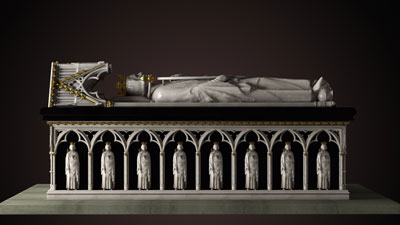In Search of Robert Bruce
Published: 5 September 2023
Dr. Martin MacGregor
This project is ongoing and to date has largely been supported by Glasgow University’s Chancellor’s Fund. It is a collaboration between Scottish History and the Hunterian Museum at the University of Glasgow, and Face Lab – formerly based at the University of Dundee and now at Liverpool John Moores University – which specialises in facial identification and craniofacial reconstruction. Phase 1 of the project also involved colleagues from Genetics at the University of Glasgow, and Glasgow Museums. Phase 1 was based upon the skull cast held in the Hunterian taken from a skeleton excavated from a tomb within the ruins of Dunfermline Abbey on 5 November 1819. At that time the skeleton was believed to be that of Robert Bruce or Robert I, king of Scots from 1306 to 1329. The aim of Phase 1 was to create craniofacial images of the individual whose skull this was, and to investigate whether these could indeed be accepted as visual likenesses of Robert Bruce. See below for a link to the images, and a list of articles generated by Phase 1. These discuss the process of creating the images; the case for identifying the image with Bruce, including fresh discussion of whether Bruce had leprosy; the location of the tombs of medieval Scottish monarchs at Dunfermline and the implications for the evolution of medieval church building there; and aspects of Bruce’s kingship and personality. The overall conclusion of this research was that the association between the tomb and skeleton excavated in 1819 and Robert Bruce is probably correct; Bruce fits the relevant criteria better than any other known candidate. Phase 2 has funded the creation of a 3-D version of the main craniofacial image, complete with defensive armour and headgear, which will become a part of the Hunterian’s collections and be the subject of a forthcoming ‘Object in Focus’ exhibition, with associated talks by leading authorities. It is also funding the investigation of an artefact which came to light as a result of Phase 1, and which claims to consist of fragments of metatarsal bone and coffin wood taken from the Dunfermline skeleton and tomb in 1819. The bone is currently undergoing DNA analysis by Prof. Turi King of the University of Leicester. The wood fragments will undergo radiocarbon testing at the Radiocarbon Laboratory at the Scottish Universities Environmental Research Campus (SUERC) at East Kilbride, for dating evidence. These investigations may provide new evidence about the identity of the incumbent of the Dunfermline tomb, and, potentially, about Robert Bruce.
For further information contact Dr Martin MacGregor, Scottish History: Martin.MacGregor@glasgow.ac.uk

First published: 5 September 2023
<< Research

